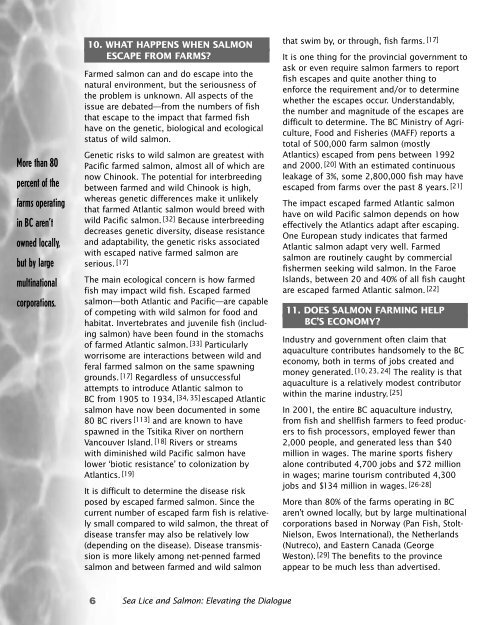Sea Lice AND Salmon - Farmed And Dangerous
Sea Lice AND Salmon - Farmed And Dangerous
Sea Lice AND Salmon - Farmed And Dangerous
Create successful ePaper yourself
Turn your PDF publications into a flip-book with our unique Google optimized e-Paper software.
More than 80percent of thefarms operatingin BC aren’towned locally,but by largemultinationalcorporations.10. WHAT HAPPENS WHEN SALMONESCAPE FROM FARMS?<strong>Farmed</strong> salmon can and do escape into thenatural environment, but the seriousness ofthe problem is unknown. All aspects of theissue are debated—from the numbers of fishthat escape to the impact that farmed fishhave on the genetic, biological and ecologicalstatus of wild salmon.Genetic risks to wild salmon are greatest withPacific farmed salmon, almost all of which arenow Chinook. The potential for interbreedingbetween farmed and wild Chinook is high,whereas genetic differences make it unlikelythat farmed Atlantic salmon would breed withwild Pacific salmon. [32] Because interbreedingdecreases genetic diversity, disease resistanceand adaptability, the genetic risks associatedwith escaped native farmed salmon areserious. [17]The main ecological concern is how farmedfish may impact wild fish. Escaped farmedsalmon—both Atlantic and Pacific—are capableof competing with wild salmon for food andhabitat. Invertebrates and juvenile fish (includingsalmon) have been found in the stomachsof farmed Atlantic salmon. [33] Particularlyworrisome are interactions between wild andferal farmed salmon on the same spawninggrounds. [17] Regardless of unsuccessfulattempts to introduce Atlantic salmon toBC from 1905 to 1934, [34, 35] escaped Atlanticsalmon have now been documented in some80 BC rivers [113] and are known to havespawned in the Tsitika River on northernVancouver Island. [18] Rivers or streamswith diminished wild Pacific salmon havelower ‘biotic resistance’ to colonization byAtlantics. [19]It is difficult to determine the disease riskposed by escaped farmed salmon. Since thecurrent number of escaped farm fish is relativelysmall compared to wild salmon, the threat ofdisease transfer may also be relatively low(depending on the disease). Disease transmissionis more likely among net-penned farmedsalmon and between farmed and wild salmonthat swim by, or through, fish farms. [17]It is one thing for the provincial government toask or even require salmon farmers to reportfish escapes and quite another thing toenforce the requirement and/or to determinewhether the escapes occur. Understandably,the number and magnitude of the escapes aredifficult to determine. The BC Ministry of Agriculture,Food and Fisheries (MAFF) reports atotal of 500,000 farm salmon (mostlyAtlantics) escaped from pens between 1992and 2000. [20] With an estimated continuousleakage of 3%, some 2,800,000 fish may haveescaped from farms over the past 8 years. [21]The impact escaped farmed Atlantic salmonhave on wild Pacific salmon depends on howeffectively the Atlantics adapt after escaping.One European study indicates that farmedAtlantic salmon adapt very well. <strong>Farmed</strong>salmon are routinely caught by commercialfishermen seeking wild salmon. In the FaroeIslands, between 20 and 40% of all fish caughtare escaped farmed Atlantic salmon. [22]11. DOES SALMON FARMING HELPBC’S ECONOMY?Industry and government often claim thataquaculture contributes handsomely to the BCeconomy, both in terms of jobs created andmoney generated. [10, 23, 24] The reality is thataquaculture is a relatively modest contributorwithin the marine industry. [25]In 2001, the entire BC aquaculture industry,from fish and shellfish farmers to feed producersto fish processors, employed fewer than2,000 people, and generated less than $40million in wages. The marine sports fisheryalone contributed 4,700 jobs and $72 millionin wages; marine tourism contributed 4,300jobs and $134 million in wages. [26-28]More than 80% of the farms operating in BCaren’t owned locally, but by large multinationalcorporations based in Norway (Pan Fish, Stolt-Nielson, Ewos International), the Netherlands(Nutreco), and Eastern Canada (GeorgeWeston). [29] The benefits to the provinceappear to be much less than advertised.6 <strong>Sea</strong> <strong>Lice</strong> and <strong>Salmon</strong>: Elevating the Dialogue
















